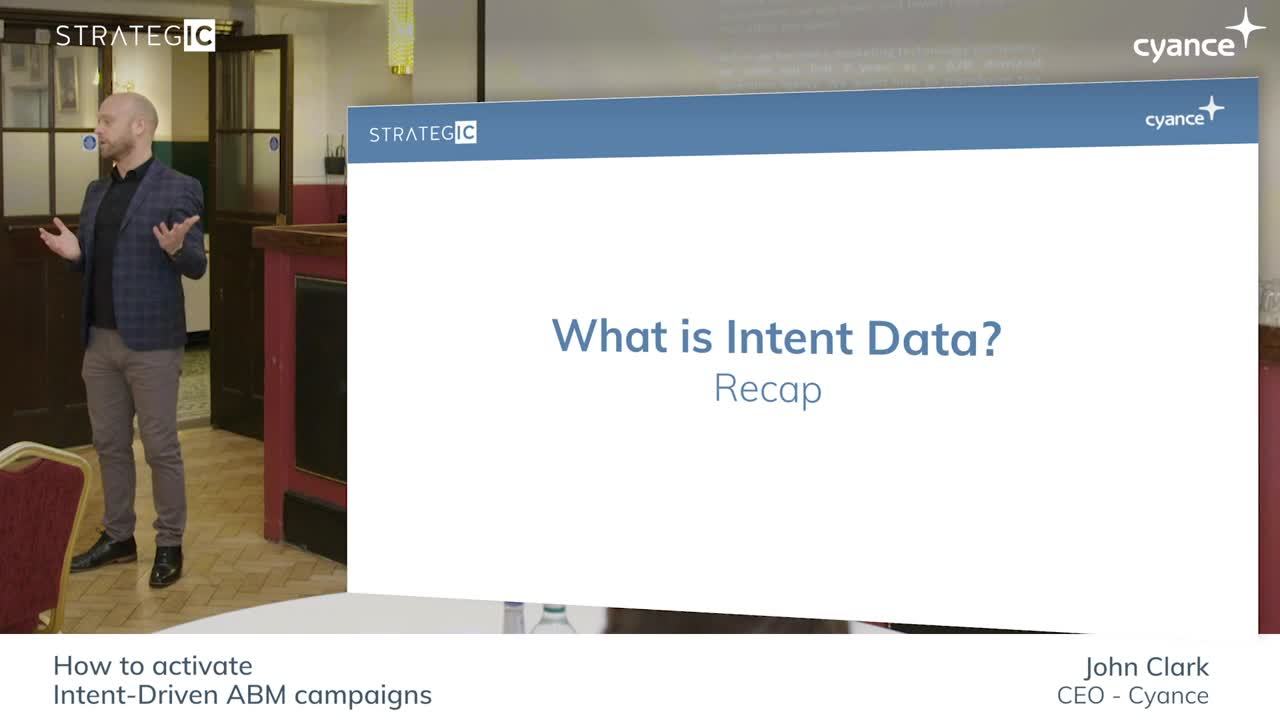How did intent data come to be so valuable in delivering intelligent, effective marketing and sales campaigns, and why are organisations increasingly incorporating buying intent data into their strategic mix?
Jon Clarke on the Origins of Intent Data, and its Value to Marketing and Sales
In this video, taken from our March 2019 event, John Clarke CEO of B2B intent platform Cyance explores the origins of marketing with intent; looking at what caused them to explore the space, and how the landscape has changed.
Strategic CEO Alex Embling and Cyance CEO Jon Clark will outline more in our London ABM Workshop: Identify Accounts In-Market for your Technology on May 22nd. You can learn more, or sign up here.

"What is Intent Data? Why Does It Exist?" Jon Clarke on the Origins of Intent Data, and Its Value to Marketing and Sales
Video Transcript:
On why Cyance as a technology provider, and the intent data focus exists:
Okay. So what is B2B intent data? Why does it exist?
For Cyance, before we became a technology company, our sole role in life was to help our customers win new customers. So; generating leads. We tried to be as data-driven as we possibly could. But in those days, the only data available was firmographic and contact data.
You might get a little bit of tech install data, but outside of that, there wasn't much. So, what that meant [for organisations] was that you would try to establish "Well, what does a good customer look like?". This would often be in terms of sector size or country. [You'd ask questions such as] "can I get contacts that I think might be in the decision making unit?" "Am I working on some kind of personas?" "Can I understand what kind of technology they may have and bought?" "Does that give me any insights?"
But outside of that, there wasn't much else to go by other than when you engaged with customers and prospects, and you maybe recorded that in your CRM technology.
On why an intent focus is so crucial to marketing and sales:
So what that [lack of intent insight] meant was, that if you were either a client-side marketing or sales function, your only real opportunity, in order to deliver on your targets to feed the very hungry sales engine, was to throw as much mud at the wall as you possibly could.
What we noticed, probably about four or five years ago, was that the dials were changing slightly, in the wrong direction. And when we did some investigation, we realised that buying behaviours were changing. And it's because of the prevalence of the internet.
[You'd do this] hoping some of it sticks, on the basis that statistically, if you reached enough people that someone's gonna say, "oh great, I'd like to talk to you". That's really, really speculative, very inefficient, and very expensive. But when you have to do more with less, you have to run really quickly, the market's always changing, your competition is very fierce - and your market is quite large - you really didn't have much of a choice.
So it was a numbers game. It was volume. It was mass marketing, and it kind of worked - for a while. But what we noticed, probably about four or five years ago, was that the dials were changing slightly, in the wrong direction. And when we did some investigation, we realised that buying behaviours were changing. And it's because of the prevalence of the internet, the ability to access information online, which means it [information] has become increasingly available to us all. And as a consequence, we've all stopped listening to unsolicited sales and marketing messages.
On reaching and resonating with the consumer today:
As consumers, how we act on an individual basis is very reflective of how we act if we're in a decision making unit, or a buying group in our daily working lives. [In both instances] we determine what we do when we research how to solve a pain point, or reach a business objective. We determine where we go to do that research. And [we decide] what is useful to us at any one point in time.
So if you have unsolicited sales and marketing messages, the reality is most people inside those buying groups are less receptive to them. And that's a real problem, both if you're an agency, but also if your client-side, because you're there to actually generate opportunity; whether that's winning new customers or retaining and upselling to existing or both.
As consumers, how we act on an individual basis is very reflective of how we act if we're in a decision making unit, or a buying group in our daily working lives... So if you have unsolicited sales and marketing messages, the reality is most people inside those buying groups are less receptive to them.
On incorporating intent into strategies today:
So that's what started to pivot us [Cyance] to thinking around, well, okay, if this is happening and if you accept that this is happening more and more, and people are going online to do that research, is it feasible to pick up on those breadcrumb trails - those signals that are being emitted when that type of [intent] activity takes place inside the organisations that I care about? And the short answer to a very long investigation process was that you could, and that's what started us on this journey.
Is it feasible to pick up on those breadcrumb trails - those signals that are being emitted when that type of [intent] activity takes place inside the organisations that I care about? The short answer to a very long investigation process was that you could.
We call it behavioural based marketing. It's marketing to accounts, and also marketing to a group of accounts. It's a combination of all of those things. But it's also about using insights from customer behaviour in order to make decisions around what accounts you prioritise for marketing and sales outreach.
And it's then about how can you use those insights to be able to understand, well, what are [your target accounts] interested in? What are their needs? What stage of the buying journey are they at? And can I use that insight in a very agile way to be able to drive better marketing engagement and inform and enable and empower the sales team?
How can you use those insights to be able to understand, well, what are [your target accounts] interested in? And how can I use that insight in a very agile way to be able to drive better marketing engagement and inform and enable and empower the sales team?




